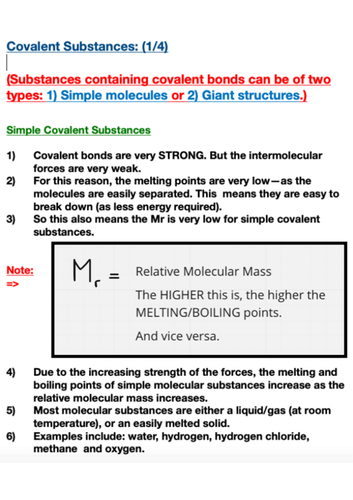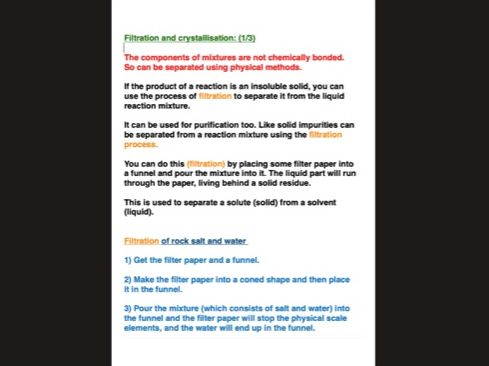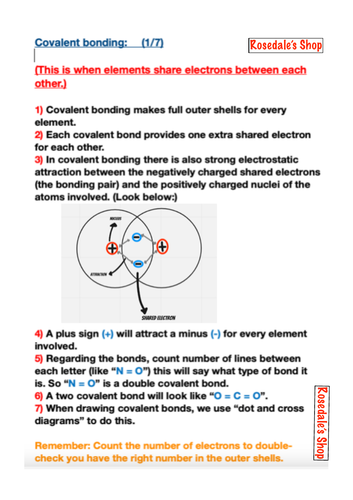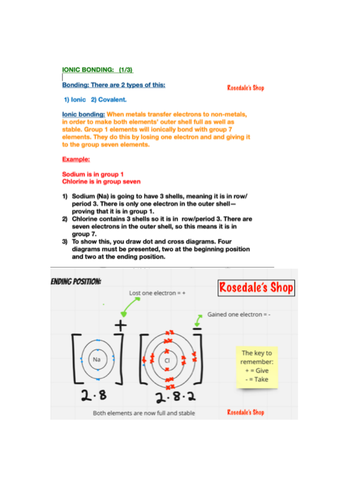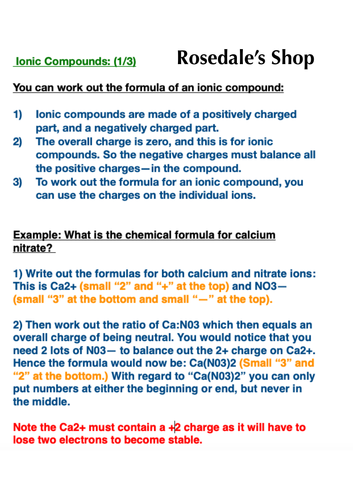954Uploads
61k+Views
19k+Downloads
Chemistry

Chemistry Definitions | Solutions | AQA Edexcel Exams | GCSE / IGCSE | Study Notes - Exam Revision
This is a FREE PDF discussing chemistry definitions on:
Dissolving, Solutions, Solute, Solvent, Saturated solution and Solubility.
Also discussed is graphs of solubility, and how to label the x and y axis.
These have been compiled by a student who achieved a Grade 8 in her IGCSE exams in 2020 where she personally used these succinct pages to revise from. DOWNLOAD NOW TO VIEW ALL PAGES .
We hope to be able to provide further fun, colourful, clear and comprehendible PDFs for you in the future.
Have a good day and make sure to follow us on…
@rosedale_academy_online (Insta)
@RosedaleEdu2020 (Twitter)
Rosedale Academy ~ YouTube/Pinterest

The Periodic Table ~ Group 1 & Group 7! GCSE/IGCSE Chemistry 9-1 Course
This is a PDF regarding Group 1 and Group 7 of the Periodic Table.
It will exhibit information regarding the following:
What is the reactivity like going down Group 1?
What is the reactivity like going down group 7?
What is the boiling and melting point like going down Group 1?
What is the boiling and melting point like going down Group 7?
What are Group 1 elements called?
What are Group 7 elements called?
The names of Group 1 and Group 7 elements are then shown.
On the last page of the PDF a worksheet is presented for you to have complete…
Click the download button NOW to view the entire resource!
Total Number of Pages: 11
#Chemistry #AQA #Edexcel #GCSE #IGCSE #PeriodicTable #Reactivity #Group1 #Group7
NOTE: These have been compiled by a student who achieved a Grade 8 in her IGCSE exams in 2020 where she personally used these succinct pages to revise from.
We hope to be able to provide further fun, colourful, clear and comprehendible PDFs for you in the future.
Have a good day and make sure to follow us on…
@rosedale_academy_online (Insta)
@RosedaleEdu2020 (Twitter)
Rosedale Academy ~ YouTube/Pinterest

Chemistry Lesson on Covalent Substances | Science for Secondary School
A detailed resource discussing covalent substances, that can be used as a lesson guide for teachers, or a revision source for students to obtain a full insight to this chemistry subject.
In addition, this PDF can be used to print and handout to students to aid them increase science reading comprehension and science literacy in your classroom. Ultimately, this resource is undoubtedly helpful as a revision guide to those about to embark on secondary-school exams, as these pages were revision notes students learnt from, aiding all to pass with A-A* grades, and nothing below!
What the PDF comprises of?
-Info regarding Simple Covalent Substances (with Relative Molecular Mass)
-Info on Giant Covalent Substances
-Structure of Diamond, with notes
-Structure of Graphite, with notes
-Notes on C60 Fullerene
The topic presented above is in line with the CGP IGCSE chemistry revision guide, alongside a teacher’s additional notes based on each subject. These detailed revision pages, or if you’d like to refer to them as a lesson plan, have been compiled by former students who have obtained an A-A* (level 8) grade in their exam papers. So feel assured the work is top-quality, as these were the pages they studied from, to possess some superb, great grades!
TOTAL PAGES: 4
You can choose to print off the lesson and teach/study the information within, or have the ultimate access to it online, due to everything comprised being demonstrated clearly, with computerised writings/images!
NOTE: This is great bunch of a resource for GCSE and IGCSE classes as the work is concise; bright; and a must buy! (If you are not desiring IGCSE content, this will doubtlessly aid in general secondary school, science studies!)
If you download this, and are pleased with it, we would be extremely grateful if you could leave a kind review. *Thank you
Tags: Chemistry, Printable, Revision Source, Science, KS3, KS4, GCSE, IGCSE, AQA, Edexcel, OCR, Cambridge, Chemistry Study Notes, Revision Notes, lesson plan, revision notes, Simple Covalent Substances, Relative Molecular Mass, Mr, Giant Covalent Substances, Diamond, Graphite, C60 Fullerene, Covalent Substances.
As always, please feel free to ask ANY and ALL questions before downloading.
All rights reserved by author. Permission to copy for single classroom use only. Electronic distribution limited to single classroom use only. Not for public display.
We hope to be able to provide further fun, colourful, clear and comprehendible PDFs for you in the future.
Have a good day and make sure to follow us on…
TpT: https://www.teacherspayteachers.com/Store/Rosedales-Shop
@rosedale_academy_online (Insta)
@RosedaleEdu2020 (Twitter)
Rosedale Academy ~ YouTube/Pinterest

Chemistry 9-1 Simple & Fractional Distillation Revision Notes | KS3 GCSE / IGCSE AQA Edexcel Study
There are two types of distillation, and both are highlighted in this PDF.
Firstly, we discuss simple distillation, moving on, we outline the example of how this is used when it comes to ethanol and water.
Lastly we mention fractional distillation with all its glory information.
All techniques are noted down in full detail, with additional side notes to further one’s knowledge on this topic ~ so be sure to download now to gain full access to this document.
These snappy chemistry notes have been compiled/used by students who very recently received a Grade 8 in their IGCSE exams.
We hope to be able to provide further fun, colourful, clear and comprehendible PDFs for you in the future.
Have a good day and make sure to follow us on…
@rosedale_academy_online (Insta)
@RosedaleEdu2020 (Twitter)
Rosedale Academy ~ YouTube/Pinterest

Chromatography Revision Lesson ~ Separation Techniques - Finding Rf Values GCSE /IGCSE AQA Edexcel
The separation technique of mixtures is chromatography.
In exams you will be expected to know how to separate a mixture to see whether certain substances are within them.
Our PDF provides the steps to tackle this, and also discussed is the formula to calculate Rf values.
For this latter part there are also indispensable precautions that have to be taken to ensure you obtain the correct answers. Thus, be sure to DOWNLOAD our PDF NOW to gain all the detailed pages on this chemistry subject.
These snappy chemistry notes have been compiled & personally used by students who very recently received a Grade 8 in their IGCSE exams.
We hope to be able to provide further fun, colourful, clear and comprehendible PDFs for you in the future.

Elements, Compound and Mixtures Revision Notes GCSE / IGCSE AQA - Edexcel - Study Notes - Exam Help
This is a detailed PDF concerning the topic: Elements / Compounds / Mixtures
It includes a variety of information concerning the following:
-Elements consists of one atom only
-Compounds are chemically bonded
-Mixtures are easily separated
-A mixture is NOT a pure substance
These succinct chemistry notes have been compiled by a student who very recently received a Grade 8 in her IGCSE exams.
We hope to be able to provide further fun, colourful, clear and comprehendible PDFs for you in the future.
Have a good day and make sure to follow us on…
@rosedale_academy_online (Insta)
@RosedaleEdu2020 (Twitter)
Rosedale Academy ~ YouTube/Pinterest

KS3 Investigating Solubility - How temperature effects solubility & Calculating Solubility Chemistry
Within this PDF, we discuss how a solid is effected by temperature. Moving on, the next page of the document involves calculations related to this topic, and we present the solubility formula that one should know from memory before upcoming exams!
#GCSE #Formula #Solubility #IGCSE #Chemistry #Edexcel #AQA
These detailed notes have been compiled by a student who achieved a Grade 8 in her IGCSE exams in 2020 where she personally used these succinct pages to revise from.
DOWNLOAD NOW TO VIEW ALL PAGES .
We hope to be able to provide further fun, colourful, clear and comprehendible PDFs for you in the future.
Have a good day and make sure to follow us on…
@rosedale_academy_online (Insta)
@RosedaleEdu2020 (Twitter)
Rosedale Academy ~ YouTube/Pinterest

Atoms - Atomic Structure Notes - Study Notes - GCSE / IGCSE - Edexcel - AQA - Exam Help - Revision
This PDF will include details regarding:
Protons
-Neutrons
-Electrons
-Relative Charge
-Relative mass
-The nucleus
-Atomic number
-Mass number
-Molecules
DOWNLOAD NOW TO VIEW ALL PAGES
We hope to be able to provide further fun, colourful, clear and comprehendible PDFs for you in the future.
Have a good day and make sure to follow us on…
@rosedale_academy_online (Insta)
@RosedaleEdu2020 (Twitter)
Rosedale Academy ~ YouTube/Pinterest

Isotopes and Relative Atomic Mass GCSE / IGCSE Edexcel - AQA Notes - Study Notes Exam Revision
This is a detailed PDF concerning Isotopes and Relative Atomic Mass.
What’s included in this PDF :
-Definition of Isotopes
-Properties of Carbon-12
-Properties of Carbon-13
-Relative Atomic Mass of Isotopes
-The relative Atomic Mass of Chlorine is Calculated
To view the complete revision notes press the DOWNLOAD button NOW.
These succinct chemistry notes have been compiled by a student who very recently received a Grade 8 in her IGCSE exams.
We hope to be able to provide further fun, colourful, clear and comprehendible PDFs for you in the future.
Have a good day and make sure to follow us on…
@rosedale_academy_online (Insta)
@RosedaleEdu2020 (Twitter)
Rosedale Academy ~ YouTube/Pinterest

Filtration and Crystallisation - Chemistry Study Notes - AQA | Edexcel | GCSE / IGCSE Revision Help
Within this PDF we will discuss the following:
-Step by step process of filtration of rock salt and water
-How to crystallise a product
-How to use both filtration and crystallisation to separate rock salt
-Extra side notes are also on display
These succinct chemistry notes have been compiled by a student who very recently received a Grade 8 in her IGCSE exams.
We hope to be able to provide further fun, colourful, clear and comprehendible PDFs for you in the future.
Have a good day and make sure to follow us on…
@rosedale_academy_online (Insta)
@RosedaleEdu2020 (Twitter)
Rosedale Academy ~ YouTube/Pinterest

Electron Shells Recap Lesson KS3 GCSE / IGCSE - AQA - Edexcel Study Notes | Revision Help | Exams
This is a PDF which discusses the chemistry topic “Electron Shells” in detail.
What it consists of…
-The rules of electron shells
-How to work out electronic configuration?
-An example of nitrogen is presented
-A further example of argon is also shown
-How to draw electronic structures of elements?
-Plus extra useful information + side notes!
These snappy chemistry notes have been compiled & revised by a student who very recently received a Grade 8 in her IGCSE exams.
DOWNLOAD NOW TO VIEW THE FULL PDF ON THIS CHEMISTRY TOPIC!
We hope to be able to provide further fun, colourful, clear and comprehendible PDFs for you in the future.
Have a good day and make sure to follow us on…
@rosedale_academy_online (Insta)
@RosedaleEdu2020 (Twitter)
Rosedale Academy ~ YouTube/Pinterest

Covalent Bonding Revision Guide with Dot & Cross Examples | GCSE / IGCSE / AQA/ EDEXCEL | NOTES
Detailed lesson notes on the chemistry topic of covalent bonding. The PDF can be used to print and handout to students to aid them increase science reading comprehension and science literacy in your classroom. Ultimately, this resource is undoubtedly helpful as a revision guide to those about to embark on secondary-school exams, as these pages were revision notes students learnt from, aiding all to pass with A-A* grades, and nothing below!
What the PDF comprises of?
-Description of covalent bonding (here we mention about the: Outer shells, Shared elections, Strong electrostatic attraction, positively/negatively charged electrons, bond types.)
-Examples of covalent bonding (with “dot & cross diagrams” accompanied with sides notes too!). Here we cover: Hydrogen, Chlorine, Hydrogen chloride, Ammonia, Nitrogen, Water, Oxygen Carbon dioxide, Ethane, Methane, Chloromethane & finally Ethene.
The topic presented above is in line with the CGP IGCSE chemistry revision guide, alongside a teacher’s additional notes based on each subject. These detailed revision pages, or if you’d like to refer to them as a lesson plan, have been compiled by former students who have obtained an A-A* (level 8) grade in their exam papers. So feel assured the work is top-quality, as these were the pages they studied from, to possess some superb, great grades!
TOTAL PAGES: 7
You can choose to print off the lesson and teach/study the information within, or have the ultimate access to it online, due to everything comprised being demonstrated clearly, with computerised writings/images!
NOTE: This is great bunch of a resource for GCSE and IGCSE classes as the work is concise; bright; and a must buy! (If you are not desiring IGCSE content, this will doubtlessly aid in general secondary school, science studies!)
If you download this, and are pleased with it, we would be extremely grateful if you could leave a kind review. *Thank you
Tags: Chemistry, Science, KS3, KS4, GCSE, IGCSE, AQA, Edexcel, OCR, Cambridge, Chemistry Study Notes, Revision Notes, lesson plan, revision notes, Dot and Cross Diagrams, Hydrogen, Chlorine, Hydrogen chloride, Ammonia, Nitrogen, Water, Oxygen Carbon dioxide, Ethane, Methane, Chloromethane & finally Ethene. Outer shells, Shared elections, Strong electrostatic attraction, positively/negatively charged electrons, bond types.
As always, please feel free to ask ANY and ALL questions before downloading.
All rights reserved by author. Permission to copy for single classroom use only. Electronic distribution limited to single classroom use only. Not for public display.
We hope to be able to provide further fun, colourful, clear and comprehendible PDFs for you in the future.
Have a good day and make sure to follow us on…
TpT: https://www.teacherspayteachers.com/Store/Rosedales-Shop
@rosedale_academy_online (Insta)
@RosedaleEdu2020 (Twitter)
Rosedale Academy ~ YouTube/Pinterest

Chemistry Ionic Bonding Lesson Notes | Secondary School Science | IGCSE/GCSE | AQA, Edexcel & OCR
Lesson notes based on the topic of ionic bonding, designed to teach/study to obtain the highest grade possible for end-of-year, secondary school exams.
What is discussed in the PDF:
Definition of ionic bonding & Examples
Illustration to show the end position of ionic bonding, with the shells and electrons
How you can tell what charge an element will have
Formulae of some common ions with their respected charges (that MUST be memorised for exams)
-How does the name of the element change when they lose/gain electrons
Diagram showing the classic case of sodium and chlorine, becoming sodium chloride
How do we know the number of electrons gained/lost
The topic presented above is in line with the CGP IGCSE chemistry revision guide, alongside a teacher’s additional notes based on each subject. These detailed revision pages, or if you’d like to refer to them as a lesson plan, have been compiled by former students who have obtained an A-A* (level 8) grade in their exam papers. So feel assured the work is top-quality, as these were the pages they studied from, to possess some superb, great grades!
TOTAL PAGES: 3
You can choose to print off the lesson and teach/study the information within, or have the ultimate access to it online, due to everything comprised being demonstrated clearly, with computerised writing!
NOTE: This is great bunch of a resource for GCSE and IGCSE classes as the work is concise; bright; and a must buy! (If you are not desiring IGCSE content, this will doubtlessly aid in general secondary school, science studies!)
If you download this, and are pleased with it, we would be extremely grateful if you could leave a kind review. *Thank you
Tags: Chemistry, Science, KS3, KS4, GCSE, IGCSE, AQA, Edexcel, OCR, Cambridge, Chemistry Study Notes, Revision Notes, Ionic, Ionic Bonding, Bonding, IONS, ions lost or gained, Charges of ions, Sodium and chlorine to Sodium Chloride, Diagram, charges, elements, electrons, shells, definition and examples, end position of shells and electrons, formula, formulae, lesson plan, revision notes
As always, please feel free to ask ANY and ALL questions before downloading.
All rights reserved by author. Permission to copy for single classroom use only. Electronic distribution limited to single classroom use only. Not for public display.
We hope to be able to provide further fun, colourful, clear and comprehendible PDFs for you in the future.
Have a good day and make sure to follow us on…
@rosedale_academy_online (Insta)
@RosedaleEdu2020 (Twitter)
Rosedale Academy ~ YouTube/Pinterest

Lesson Plan Notes on Ionic Compounds | Diagrams of Dot & Cross | Chemistry CLASS of GCSE AQA / IGCSE
Looking for a way to increase science reading comprehension and science literacy in your classroom? Help your students learn all about ionic compounds with this simple science reading comprehension passage, that has been compiled to teach/study from!
What is discussed in the PDF:
-Info on how to work out formula of an ionic compound
-What is the chemical formula of calcium nitrate?
-Dot & Cross Diagrams
-Info about ionic compounds’ “lattice structure”
The topic presented above is in line with the CGP IGCSE chemistry revision guide, alongside a teacher’s additional notes based on each subject. These detailed revision pages, or if you’d like to refer to them as a lesson plan, have been compiled by former students who have obtained an A-A* (level 8) grade in their exam papers. So feel assured the work is top-quality, as these were the pages they studied from, to possess some superb, great grades!
TOTAL PAGES: 3
You can choose to print off the lesson and teach/study the information within, or have the ultimate access to it online, due to everything comprised being demonstrated clearly, with computerised writings/images!
NOTE: This is great bunch of a resource for GCSE and IGCSE classes as the work is concise; bright; and a must buy! (If you are not desiring IGCSE content, this will doubtlessly aid in general secondary school, science studies!)
If you download this, and are pleased with it, we would be extremely grateful if you could leave a kind review. *Thank you
Tags: Chemistry, Science, KS3, KS4, GCSE, IGCSE, AQA, Edexcel, OCR, Cambridge, Chemistry Study Notes, Revision Notes, Ionic, Ionic Compounds, Ionic, IONS, i formula, formulae, lesson plan, revision notes, Dot and Cross Diagrams, Calcium Nitrate, Magnesium Oxide, Lattice Structure.
As always, please feel free to ask ANY and ALL questions before downloading.
All rights reserved by author. Permission to copy for single classroom use only. Electronic distribution limited to single classroom use only. Not for public display.
We hope to be able to provide further fun, colourful, clear and comprehendible PDFs for you in the future.
Have a good day and make sure to follow us on…
TpT: https://www.teacherspayteachers.com/Store/Rosedales-Shop
@rosedale_academy_online (Insta)
@RosedaleEdu2020 (Twitter)
Rosedale Academy ~ YouTube/Pinterest

Quiz Chemistry Edexcel 9-1 Paper 1 & Paper 2 Revision - Questions and Answers - Quick Revision Tips
Compiled by a Year 11 chemistry student who received a Grade 8 in her recent IGCSE exams, this is a question and answer PDF where basic questions and more harder ones are discussed.
Pages: 48
Topics:
-Moles
-Balancing Equations
-Covalent Substances
-Covalent Bonding
-Ionic Compounds
-Ionic Bonding
-Bonding
Masses in Reaction
-Percentage Yield Formula
-Water of Crystallisation
-Finding Formulae using Experiments
-Mass Numbers
-Potassium Manganate (VII) Experiment
-Moles and Concentration
-Calculating Volume
-Relative Formula Mass
-Electrolysis
-Group 7 / The Halogens
-Electronic Configuration
-Carbon Dioxide
-Group 1 / Alkali Metals
-Acids and Alkalis
-Reactivity Series
-Iron
-Titrations
-Energy Transfer in Reactions
-Displacement Reactions
-Catalysts
-The Periodic Table
-Movement of Particles
-Metals and Redox
-Bromine Gas Experiment
-Measuring Enthalpy Changes
-Displacement Reactions
-Catalysts
We hope to be able to provide further fun, colourful, clear and comprehendible PDFs for you in the future
Have a good day and make sure to follow us on…
@rosedale_academy_online (Insta)
@RosedaleEdu2020 (Twitter)
Rosedale Academy ~ YouTube/Pinterest

The Noble Gases Group 0 Worksheet with ANSWERS | Chemistry Mini Test - GCSE Edexcel - Revision
A PDF which contains question practise on the topic: Noble Gases
Grab your own copy now and have a smash at it!
Download NOW to view answers!
#Chemistry #GCSE #Edexcel
We hope to be able to provide further fun, colourful, clear and comprehendible PDFs for you in the future.
Have a good day and make sure to follow us on…
@rosedale_academy_online (Insta)
@RosedaleEdu2020 (Twitter)
Rosedale Academy ~ YouTube/Pinterest

Summary Diffusion Movement of Particles, the Three Diffusion Experiments Explained | Chemistry GCSE
This is a beneficial PDF which contains detailed notes regarding the three diffusion experiments: 1) Potassium manganate (VII) and water 2) Ammonia and Hydrogen Chloride 3) Bromine Gas .
Further Notes in this PDF:
-Definition of diffusion
-Brownian motion
These have been compiled by a student who achieved a Grade 8 in her IGCSE exams in 2020 where she personally used these succinct pages to revise from.
DOWNLOAD NOW TO VIEW ALL PAGES .
We hope to be able to provide further fun, colourful, clear and comprehendible PDFs for you in the future.
Have a good day and make sure to follow us on…
@rosedale_academy_online (Insta)
@RosedaleEdu2020 (Twitter)
Rosedale Academy ~ YouTube/Pinterest

Empirical Formula + Calculating Question and Model Answer ~ IGCSE/GCSE Chemistry 9-1 Edexcel / AQA
This is a brilliant PDF regarding the chemistry topic “empirical formula”.
A highly beneficial resource to aid GCSE as well as IGCSE students not to forget… those learning this for the very first time!
What’s included in these pages…
-Basic steps to take ensuring you work out the empirical formula of a compound correctly ( note: this is a five step process)
-An exam-style question is discussed with a model answer portrayed on the last page.
Click the download button NOW to access all pages.
Total Number of Pages: 4
#GCSE #IGCSE #Exams #Edexcel #AQA #Chemistry #Empirical #Formula #Question #Answer #Secondary #Education #PDF #Mass #Mr #Ar #Moles
These snappy chemistry notes have been compiled/used by students who very recently received a Grade 8 in their IGCSE exams.
We hope to be able to provide further fun, colourful, clear and comprehendible PDFs for you in the future.
Have a good day and make sure to follow us on…
@rosedale_academy_online (Insta)
@RosedaleEdu2020 (Twitter)
Rosedale Academy ~ YouTube/Pinterest

IGCSE Chemistry Edexcel ~ The Periodic Table -KS3- Full/Detailed Study Notes | Exam Revision
This is a PDF regarding the NEW IGCSE 9-1 chemistry topic: The Periodic Table.
Full detailed notes will be displayed on the following:
Information with regards to metals
-Information concerning non-metals
-What separates the elements on the periodic table?
-What side of the table are the metals and which side contains the non-metals?
-What are metal oxides?
-What are Group 1 elements classified as?
-As you go down group 1, what happens to the number of electrons and also what occurs to the mass number?
This PDF is great for revision purposes covering a wide range of subtopics, DOWNLOAD NOW to access ALL pages.
#GCSE #IGCSE #Exams #Edexcel #AQA #Chemistry
We hope to be able to provide further fun, colourful, clear and comprehendible PDFs for you in the future.
Have a good day and make sure to follow us on…
@rosedale_academy_online (Insta)
@RosedaleEdu2020 (Twitter)
Rosedale Academy ~ YouTube/Pinterest

Features of An Element ~ Atomic Number & Mass Number (Small PDF) GCSE/IGCSE Course 9-1
This resource will exhibit student’s revision notes regarding chemistry: The GCSE/IGCSE 9-1 course.
What’s included…
-Discussion of carbon
-What does the mass number consists of?
-What is the atomic number made of?
-How and where are both arranged on the periodic table?
Click the download button right now to access your FREE copy!
Total number of Pages: 2
Note: This is a concise PDF
#Chemistry #Edexcel #AQA #Exams #StudyNotes #carbon #AtomicNumber #MassNumber #Element #GCSE #IGCSE #StudyNotes
NOTE: These snappy chemistry notes have been compiled & personally used by a student who very recently received a Grade 8 in her IGCSE exams.
If you download this resource and are pleased with the PDF , we would be extremely grateful if you could leave a review. ~Thank you
We hope to be able to provide further fun, colourful, clear and comprehendible PDFs for you in the future.
Have a good day and make sure to follow us on…
@rosedale_academy_online (Insta)
@RosedaleEdu2020 (Twitter)
Rosedale Academy ~ YouTube/Pinterest**



